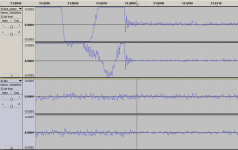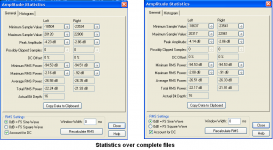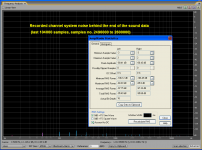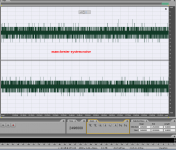Pavel
My ears prefer Blomley. The decay of chords sound more natural to me.
DiffMaker says there is a respectable sample rate drift. What was your recorder?
Finally the null achieved is low [21.4 dB (L), 21.6 dB (R)]
https://www.dropbox.com/s/9gaopcd061ebyvs/test_bolton-test_blomley%282%29.wav?dl=0
I can not depict any harsh distortion listening to the diff file. My wooly ears say I listen to the original files through an attenuator. Visual inspection of files says otherwise!
George
My ears prefer Blomley. The decay of chords sound more natural to me.
DiffMaker says there is a respectable sample rate drift. What was your recorder?
Finally the null achieved is low [21.4 dB (L), 21.6 dB (R)]
https://www.dropbox.com/s/9gaopcd061ebyvs/test_bolton-test_blomley%282%29.wav?dl=0
I can not depict any harsh distortion listening to the diff file. My wooly ears say I listen to the original files through an attenuator. Visual inspection of files says otherwise!
George
Attachments
George, the files are shifted about one sample (20 us). There is not much chance to avoid it as playback and recording are independent, so the sampling does not start at the same moment.
Please let me not disclose which file is which yet. I can only confirm that what I said is true, one file is recorded with preamp output unloaded (means some 10k of ADC input impedance) and the other one is with 10 + 50 ohm load and level matched by volume control. Thank you and the others as well for spending your time with trying the files.
Please let me not disclose which file is which yet. I can only confirm that what I said is true, one file is recorded with preamp output unloaded (means some 10k of ADC input impedance) and the other one is with 10 + 50 ohm load and level matched by volume control. Thank you and the others as well for spending your time with trying the files.
In the spirit in which this is offered up, my "roughy" (everything switched on from cold, zero normal optimising done) evaluation is this:Karl, I have used your Direct WAV file to create 2 files, one with unloaded preamp output, second with heavily loaded preamp output. If anyone would like to try and give his opinion which is which, here is the link:
https://www.dropbox.com/s/sndn8jpl5hlfigo/manchester.zip?dl=0
This test is completely unscientific, only two files and almost everything revealed 😛
bolton is superior; cleaner, more dynamic sound - blomley has a somewhat flattened sound, less sparkle.
So I guess bolton should be it,
 ...
...I very well take note of the pearls of wisdom from you, Pavel, JC, Bonsai, Christophe....and others....after that, Pavel was a "made man" in my eyes. Because of that circuit, I am always interested in his comments, I know for a fact that he knows what good sound is.
Yeah, I was returning repairs to a local high-end dealer (20 years ago).No different than with John, I had his 1205 power amp with me at home for about 10 days...
From the shop entry foyer, I noted an unusually good/correct sound emerging from the soundroom.
I enquired as to what amp was running....''That's the new Parasound...John Curl designed''.
Who is John Curl ?, I thought....now I know better, much better 😉.
So no prior knowledge, no peeking, just overhearing from the next room.
I tips me lid.
Dan.
I hope you were listening to an all analog radio station! 😀Today, I got my Marantz 10 vacuum tube tuner running! <snip> IF ONLY we could make audio that good with digital.
But I understand your happiness. Some of those old tuners did sound wonderful.
So what's the deal with your preamp PCB's? Your website states that they are not available. Will they be available in the near future?
Thanks...
George, the files are shifted about one sample (20 us). There is not much chance to avoid it as playback and recording are independent, so the sampling does not start at the same moment.
Sample rate drift refers to drifting of sample rate along the file length.
It is not affected by the time shift btn the two files (I tested it).
Your files had a sample rate drift of –2.6ppm
Mooly’s Direct WAV file has 0ppm drift (and the other files Mooly posted had a drift of -0.01ppm to –0.03ppm.
Please let me not disclose which file is which yet.
…
Thank you and the others as well for spending your time with trying the files.
You are welcome.
I am not in a hurry to read (again) the proof of gold deficiency in my ears
😀
George
Last edited:
Starting to look at Pavel's files with Audacity - and this is telling me, yet again, that DiffMaker is not up to it; I'm already up to 50dB down nulling, and I still have some way to go ...
What is interesting, so far, is that PMA's setup between the two configurations has introduced an anomaly between the channels where the gain is significantly different between left and right - the overall null is better in one channel versus the other. So, I'll have to split the channels, and apply different gains to each for optimum null.
Mooly's samples, in contrast, did not show the slightest hint of this behaviour ...
What is interesting, so far, is that PMA's setup between the two configurations has introduced an anomaly between the channels where the gain is significantly different between left and right - the overall null is better in one channel versus the other. So, I'll have to split the channels, and apply different gains to each for optimum null.
Mooly's samples, in contrast, did not show the slightest hint of this behaviour ...
And, another consideration: Pavel's files are surprisingly somewhat noisy, only 80dB down - not random, at one place, in the region of 20kHz noise ... the nulling will be limited by this.
To illustrate what I'm talking about, here is the end of the Direct file sample by Mooly, followed by circuitry noise - the vertical line at 51.008 secs delineates the two regions.

The Mix tracks are the nulling so far achieved between blomley and bolton, which will be limited by the intrinsic noise content.

The Mix tracks are the nulling so far achieved between blomley and bolton, which will be limited by the intrinsic noise content.
Yes Frank, you are right about noise. Mic input is used, which is noisier. My link input is blown.
Re volume between channels - slight difference is possible, it was necessary to set the Alps for the recording with load, as the output series resistor of 10 ohm makes a divider with 50 ohm load. The effect is in 0.01 dB order. I will post file statistics later.
Re volume between channels - slight difference is possible, it was necessary to set the Alps for the recording with load, as the output series resistor of 10 ohm makes a divider with 50 ohm load. The effect is in 0.01 dB order. I will post file statistics later.
Last edited:
So what's the deal with your preamp PCB's? Your website states that they are not available. Will they be available in the near future?
Thanks...
I am sorry, they will not be available, as audio is just a hobby to me now. This test was not meant as a promotion, I just have the preamp here, so it was easy to perform the test with 50 ohm load and this preamp is capable to drive it.
Okay, I posed a query in an earlier post, http://www.diyaudio.com/forums/loun...ch-preamplifier-part-ii-5774.html#post4111973, and no response ... the answer is Pass W is Pass 4, the last one done, and X, Y, Z correspond to 3, 2, 1.
Meaning what? Well, to my eyes it's saying that the playback/record chain was in the process of stabilising while the recordings were taking place - irrespective of how long equipment is turned on, IME, the more the paths are exercised the more they truly stabilise, and for me that is especially true whenever digital is in the picture - and Mooly's recordings are a beautiful example illustrating that behaviour: the 1st recording is a long way from the last, in terms of size of difference, in the peaks particularly, the 2nd is somewhat closer, and the 3rd almost matches the next, 4th run. A fifth would probably show virtually no difference in peak differences ...
Meaning what? Well, to my eyes it's saying that the playback/record chain was in the process of stabilising while the recordings were taking place - irrespective of how long equipment is turned on, IME, the more the paths are exercised the more they truly stabilise, and for me that is especially true whenever digital is in the picture - and Mooly's recordings are a beautiful example illustrating that behaviour: the 1st recording is a long way from the last, in terms of size of difference, in the peaks particularly, the 2nd is somewhat closer, and the 3rd almost matches the next, 4th run. A fifth would probably show virtually no difference in peak differences ...
I am sorry, they will not be available, as audio is just a hobby to me now. This test was not meant as a promotion, I just have the preamp here, so it was easy to perform the test with 50 ohm load and this preamp is capable to drive it.
You could put your PCB design and documentation out in public domain - I am sure a lot of people will build the Dispre's. Otherwise, it will just sit on your website.
You could get one of the HK DIY stores to offer the boards as well. you wont make any money out of it, but at leasts the DIY community gets to build and try your designs
🙂
I will release the phono stage gerber files very soon, as you know, circuit schematics and the BOM have been available for free since the beginning.
I will release the phono stage gerber files very soon, as you know, circuit schematics and the BOM have been available for free since the beginning.
I'm really not interested in phono stage amplifiers. Too bad you can't offer the Gerber files for the line stage amplifiers.🙁
I saw some schematics on your website, but none of the component's values were labeled:
Dispre 2 - JFET english
Can you direct me to schematics with component values and BOM?
Thanks...
Last edited:
R.I.P. Harry Pearson-TAS
I just learned that Harry Pearson died. RIP, Harry. He was only 77 and started The Absolute Sound. I knew HP and visited him often as my friend Sallie Reynolds, whom I visited at her home in Sea Cliff, lived a short walking distance from Harry's home. Harry bought me the first Audio-System One (maxed out features set) to learn what could be correlated to listening. He was always a gentle man with great tastes in all things. After I stole Sallie away (his TAS editor), he visited me and Sallie in our home in Cool, California as well. Last time I saw him, we all got in the hot tub... Hot tub and wine. Nice in the winter. He will be missed !
-Richard Marsh
I just learned that Harry Pearson died. RIP, Harry. He was only 77 and started The Absolute Sound. I knew HP and visited him often as my friend Sallie Reynolds, whom I visited at her home in Sea Cliff, lived a short walking distance from Harry's home. Harry bought me the first Audio-System One (maxed out features set) to learn what could be correlated to listening. He was always a gentle man with great tastes in all things. After I stole Sallie away (his TAS editor), he visited me and Sallie in our home in Cool, California as well. Last time I saw him, we all got in the hot tub... Hot tub and wine. Nice in the winter. He will be missed !
-Richard Marsh
IMO the version with R16, R34 connected might sound better. What is the real world result?
Thank you PMA for your comment. There is no the real world result yet, but I will put a jumper to have both possibility (it's simple). I asked that question not because I know the answer, I don't have enough listening experience, but to get others opinion about it.
What is interesting, so far, is that PMA's setup between the two configurations has introduced an anomaly between the channels where the gain is significantly different between left and right - the overall null is better in one channel versus the other. So, I'll have to split the channels, and apply different gains to each for optimum null.
And, another consideration: Pavel's files are surprisingly somewhat noisy, only 80dB down - not random, at one place, in the region of 20kHz noise ... the nulling will be limited by this.
Yes Frank, you are right about noise. Mic input is used, which is noisier. My link input is blown.
Re volume between channels - slight difference is possible, it was necessary to set the Alps for the recording with load, as the output series resistor of 10 ohm makes a divider with 50 ohm load. The effect is in 0.01 dB order. I will post file statistics later.
Attached is the file statistics, FFT noise analysis and time domain noise analysis of the last 104000 samples - the system has been recording its own noise after the end of the original Mooly's file.
Regarding sound preferences so far -
For Bolton: Max, Frank (fas42)
For Blomley: George
I am not sure about Mooly's preference - probably Bolton?
Attachments
I just learned that Harry Pearson died. RIP, Harry. He was only 77 and started The Absolute Sound. I knew HP and visited him often as my friend Sallie Reynolds, whom I visited at her home in Sea Cliff, lived a short walking distance from Harry's home. Harry bought me the first Audio-System One (maxed out features set) to learn what could be correlated to listening. He was always a gentle man with great tastes in all things. After I stole Sallie away (his TAS editor), he visited me and Sallie in our home in Cool, California as well. Last time I saw him, we all got in the hot tub... Hot tub and wine. Nice in the winter. He will be missed !
-Richard Marsh
Met a lot of nice people with Harry -- one was Bill Porter in 1988 party for him. Bill stayed at our house (Sallie's). .. Various musicians and producers. And my first visit to Carnegy Hall. Some might not know that the term Hi-End Audio came from him.
-RNM
- Status
- Not open for further replies.
- Home
- Member Areas
- The Lounge
- John Curl's Blowtorch preamplifier part II



